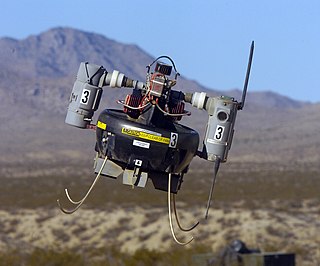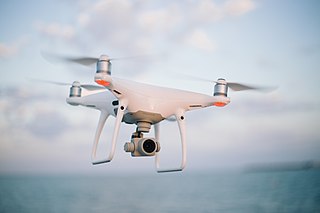
An unmanned aerial vehicle (UAV), commonly known as a drone, is an aircraft without any human pilot, crew, or passengers on board. UAVs were originally developed through the twentieth century for military missions too "dull, dirty or dangerous" for humans, and by the twenty-first, they had become essential assets to most militaries. As control technologies improved and costs fell, their use expanded to many non-military applications. These include aerial photography, precision agriculture, forest fire monitoring, river monitoring, environmental monitoring, policing and surveillance, infrastructure inspections, smuggling, product deliveries, entertainment, and drone racing.

Boids is an artificial life program, developed by Craig Reynolds in 1986, which simulates the flocking behaviour of birds. His paper on this topic was published in 1987 in the proceedings of the ACM SIGGRAPH conference. The name "boid" corresponds to a shortened version of "bird-oid object", which refers to a bird-like object.

A micro air vehicle (MAV), or micro aerial vehicle, is a class of man-portable miniature UAVs whose size enables them to be used in low altitude, close-in support operations. Modern MAVs can be as small as 5 centimeters. Development is driven by commercial, research, government, and military purposes; with insect-sized aircraft reportedly expected in the future. The small craft allows remote observation of hazardous environments inaccessible to ground vehicles. MAVs have been built for hobby purposes such as aerial robotics contests and aerial photography.

Swarm robotics is an approach to the coordination of multiple robots as a system which consist of large numbers of mostly simple physical robots. ″In a robot swarm, the collective behavior of the robots results from local interactions between the robots and between the robots and the environment in which they act.″ It is supposed that a desired collective behavior emerges from the interactions between the robots and interactions of robots with the environment. This approach emerged on the field of artificial swarm intelligence, as well as the biological studies of insects, ants and other fields in nature, where swarm behaviour occurs.

A quadcopter, also called quadrocopter, or quadrotor is a type of helicopter that has four rotors.
The Institute of Robotics and Intelligent Systems (IRIS) is part of the ETH Zurich, Switzerland. It replaced the existing Institute of Robotics, of the ETH Zurich in October 2002, when Prof. Bradley J. Nelson moved from the University of Minnesota, United States, to ETH Zurich, and succeeded the Prof. Dr. Gerhard Schweitzer.

Aurora Flight Sciences is an American aviation and aeronautics research subsidiary of Boeing which primarily specializes in the design and construction of special-purpose Unmanned aerial vehicles. Aurora has been established for 20+ years and their headquarters is at the Manassas Regional Airport in Manassas, Virginia.

The Elbit Systems Hermes 900 Kochav ("Star") is an Israeli medium-size, multi-payload, medium-altitude long-endurance unmanned aerial vehicle (UAV) designed for tactical missions. It is a successor to the Hermes 450 series of drones, one of the most widely used military drones in the world.

The UMS Skeldar V-200 is a medium-range VTOL UAV developed by the Swedish aerospace company Saab. The Skeldar can be used for surveillance, intelligence gathering, light cargo transportation, and electronic warfare.
CASC Rainbow is a series of unmanned aerial vehicles (UAVs) developed by the China Academy of Aerospace Aerodynamics, an entity under the China Aerospace Science and Technology Corporation (CASC). The China Academy of Aerospace Aerodynamics is also known as the 11th Academy of CASC, or 701st Research Institute.

The DelFly is a fully controllable camera-equipped flapping wing Micro Air Vehicle or Ornithopter developed at the Micro Air Vehicle Lab of the Delft University of TechnologyArchived 2019-10-19 at the Wayback Machine in collaboration with Wageningen University.

Raffaello D’Andrea a Canadian-Italian-Swiss engineer, artist, and entrepreneur. He is professor of dynamic systems and control at ETH Zurich. He is a co-founder of Kiva Systems, and the founder of Verity. He was the faculty advisor and system architect of the Cornell Robot Soccer Team, four time world champions at the annual RoboCup competition. He is a new media artist, whose work includes The Table, the Robotic Chair, and Flight Assembled Architecture.
The Hellenic Civil Unmanned Aerial Vehicle (HCUAV) RX-1 is a Greek research project, which has currently produced a prototype of a Medium Altitude - Long Endurance (MALE) Unmanned Aerial Vehicle (UAV), with aim for the aircraft to enter production in the future and be utilised in civil and potentially, military operations.
An autonomous aircraft is an aircraft which flies under the control of automatic systems and needs no intervention from a human pilot. Most autonomous aircraft are unmanned aerial vehicle or drones. However, autonomous control systems are reaching a point where several air taxis and associated regulatory regimes are being developed.
Unmanned aerial vehicles (UAVs), commonly known as drones, can be used for data collection and analysis, surveillance, research, filmmaking, and other general usage, and although this technology was once reserved for military use through the 1990’s and early 2000’s, it now has usage among civilians. Since the 2000s, drone technology has improved to include developments in commercial applications such as deliveries and passenger transportation. More specifically, Ehang, a technology company based in Guangzhou, China, has developed the Ehang 184, the world's first passenger drone. These advancements in drone technology have led to many more developments and usage in the aspect of passenger transportation.
Networked flying platforms (NFPs) are unmanned flying platforms of various types including unmanned aerial vehicles (UAVs), drones, tethered balloon and high-altitude/medium-altitude/low-altitude platforms (HAPs/MAPs/LAPs) carrying RF/mmWave/FSO payload (transceivers) along with an extended battery life capabilities, and are floating or moving in the air at a quasi-stationary positions with the ability to move horizontally and vertically to offer 5G and beyond 5G (B5G) cellular networks and network support services.
Davide Scaramuzza is an Italian professor of robotics at the University of Zurich, specialising on micro air vehicles.

Drones, also known as Unmanned Aerial Systems/Vehicles (UAS/UAV), or Remotely Piloted Aircraft, are used in wildfire surveillance and suppression. They help in the detection, containment, and extinguishing of fires. They are also used for locating a hot spot, firebreak breaches, and then to deliver water to the affected site. In terms of maneuverability, these are superior to a helicopter or other forms of manned aircraft. They help firefighters determine where a fire will spread through tracking and mapping fire patterns. These empower scientists and incident personnel to make informed decisions. These devices can fly when and where manned aircraft are unable to fly. They are associated with low cost and are flexible devices that offer a high spatiotemporal resolution.

Margarita Chli is an assistant professor and leader of the Vision for Robotics Lab at ETH Zürich in Switzerland. Chli is a leader in the field of computer vision and robotics and was on the team of researchers to develop the first fully autonomous helicopter with onboard localization and mapping. Chli is also the Vice Director of the Institute of Robotics and Intelligent Systems and an Honorary Fellow of the University of Edinburgh in the United Kingdom. Her research currently focuses on developing visual perception and intelligence in flying autonomous robotic systems.













